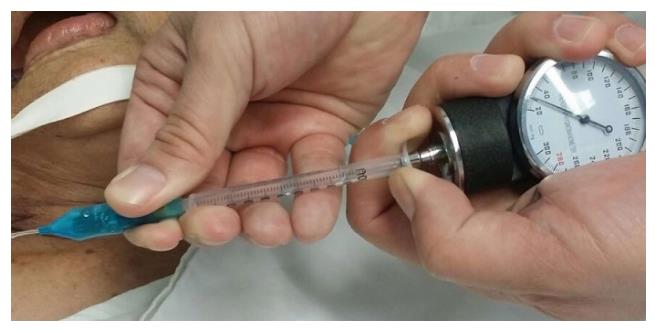Published online Mar 27, 2016. doi: 10.5313/wja.v5.i1.36
Peer-review started: September 23, 2015
First decision: October 30, 2015
Revised: November 26, 2015
Accepted: December 18, 2015
Article in press: December 21, 2015
Published online: March 27, 2016
Processing time: 187 Days and 0.4 Hours
We agree with the editorial published by Feng et al concerning the insufficient routine monitoring of tracheal tube cuff pressure (TTCP) by anesthesiologists, and propose an improvised technique that can facilitate and promote such routine monitoring by intensive care staff who attend to patients receiving mechanical ventilation. Insufficient monitoring of tracheal cuff pressure has also been documented for intensive care unit nurses. Measurements of cuff pressure are beneficial when used in management of air leakage around an endotracheal tube, and can be easily obtained with the aid of a personalized and simple technique performed using materials that are readily available in all hospitals. Other investigators have previously demonstrated the usefulness of employing an improvised technique. We considered that possible disadvantages are similar to those encountered when using standardized equipment. With our improvised technique, we seek to promote among the nursing staff the determination of the TTCP in intubated patients to reduce the risk of related medical complications.
Core tip: This letter to the editor supports an opinion expressed in an article recently published in the World Journal of Anesthesiology. In that article, Feng et al mentioned that despite evidence suggesting its benefits, anesthesiologists often do not measure a patient’s endotracheal tube cuff pressure. We suggest an improvised and personalized technique that can be employed to facilitate taking such measurements on a routine basis in the setting of an intensive care unit with limited resources.
- Citation: Flores-Franco RA. Improvised technique for measuring tracheal tube cuff pressure. World J Anesthesiol 2016; 5(1): 36-37
- URL: https://www.wjgnet.com/2218-6182/full/v5/i1/36.htm
- DOI: https://dx.doi.org/10.5313/wja.v5.i1.36
We read with great interest the editorial written by Feng et al[1], which stated that despite evidence supporting the benefits of monitoring tracheal tube cuff pressure (TTCP), such monitoring is not routinely performed in clinical practice. We support the point of view expressed by those authors, and believe it would be also applicable when monitoring patients in intensive care units (ICUs). Surveys performed in other centers have revealed that approximately 50% of nurses working in adult ICUs do not routinely determine TTCP, even when an audible air leak is detected[2]. Unlike air leakage resulting from structural damage, air leakage accompanied by normal or elevated TTCP can result from partial tracheal extubation, inadvertent intratracheal placement of the gastric tube, high mean airway pressure or a discrepancy between diameters of the endotracheal tube and trachea[3].
The high cost and limited availability of equipment specifically designed to measure cuff pressure makes such measurements difficult to perform on a routine basis in our ICUs. To overcome this problem, we have designed a simple technique for measuring cuff pressure that can be performed with readily available materials. When using this technique, a 1 mL syringe is interposed between a blood pressure manometer and the pilot balloon of the endotracheal tube (Figure 1). Optionally, a 3-way stopcock can also be interposed to add or remove air, and achieve the desired pressure level.
An additional advantage of this technique is that the required materials can be easily disposed of after their use, and thus the risk of transmitting an infection is minimized. On the other hand, one possible disadvantage is that a small loss of air volume may occur while handling the pilot balloon; however, this can also occur when using more expensive equipment.
The effectiveness of using an improvised technique to determine TTCP has previously been demonstrated by other authors, who reported results comparable with those achieved when using standard equipment, and even better results than those achieved using the pilot balloon palpitation technique[4]. Thus, we believe that our simple and practical method may strengthen protocols which call for measurements of TTCP in hospitals with limited resources.
P- Reviewer: Grignola JC, Leone A S- Editor: Ji FF L- Editor: A E- Editor: Jiao XK
| 1. | Feng TR, Ye Y, Doyle DJ. Clinical importance of tracheal tube cuff pressure management. World J Anesthesiol. 2015;4:10-12. [RCA] [DOI] [Full Text] [Full Text (PDF)] [Cited by in CrossRef: 12] [Cited by in RCA: 9] [Article Influence: 0.9] [Reference Citation Analysis (13)] |
| 2. | Jordan P, van Rooyen D, Venter D. Endotracheal tube cuff pressure management in adult critical care units. S Afr J Crit Care. 2012;28:13-16. [RCA] [DOI] [Full Text] [Cited by in Crossref: 13] [Cited by in RCA: 13] [Article Influence: 1.0] [Reference Citation Analysis (0)] |
| 3. | El-Orbany M, Salem MR. Endotracheal tube cuff leaks: causes, consequences, and management. Anesth Analg. 2013;117:428-434. [RCA] [PubMed] [DOI] [Full Text] [Cited by in Crossref: 34] [Cited by in RCA: 46] [Article Influence: 3.8] [Reference Citation Analysis (0)] |
| 4. | Goyal MR, Kumar LCG, Waghray MGMR. Endotracheal tube cuff pressure monitoring in peripheral hospitals. MJAFI. 2006;62:243-245. [RCA] [DOI] [Full Text] [Cited by in Crossref: 7] [Cited by in RCA: 3] [Article Influence: 0.2] [Reference Citation Analysis (0)] |









